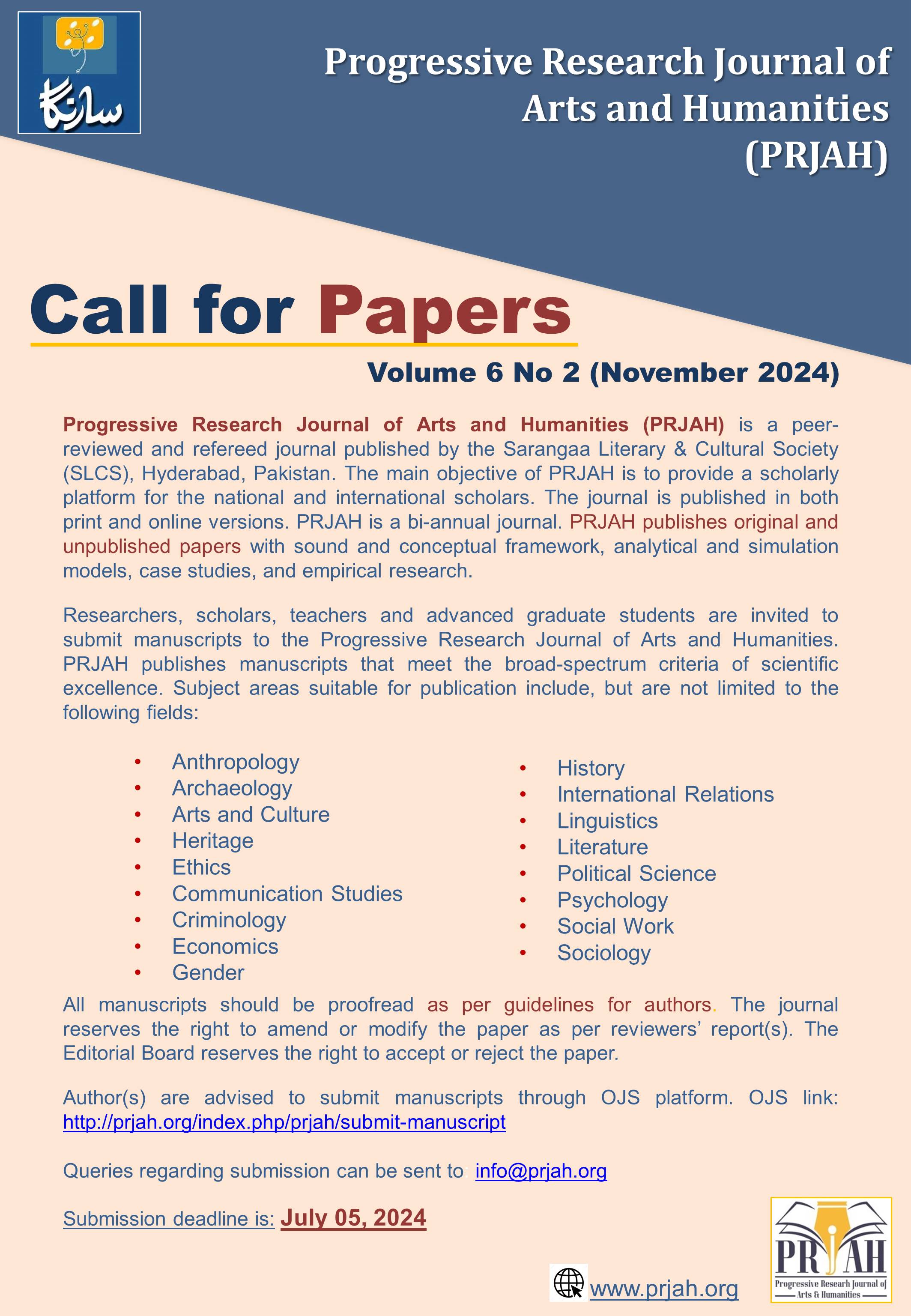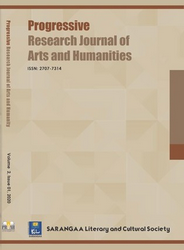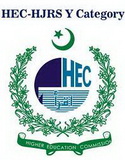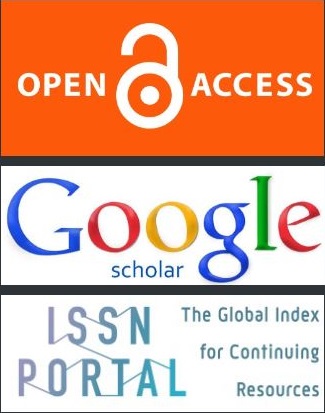The Moderating and Mediating effects of Low Income and feelings of Perceived Deprivation on Madrassa Students
DOI:
https://doi.org/10.51872/prjah.vol6.Iss1.306Keywords:
Radicalization; Madrassa; Perceived Deprivation; Low Income; Sindh.Abstract
Religious education in the country like Pakistan is considered mandatory and when it comes to make for life choices, majority of the parents chose religious education. Hence, majority madrassas students come from poor background because they cannot afford or acquire education in general subjects, compared to kids of their age studying in private and government schools which leads to feelings of perceived deprivation. To measure the impact of such deprived feelings on the madrassa students, this study applied quantitative method to examine the impact of perceived feelings. Out of 283 registered madrassas, 40 were selected randomly, whereas, 25 Questionnaires were distributed to each madrassa. The model was tested using structural equation modeling to examine the effects of low and high income, and the mediating impact of perceived deprivation on the criterion constructs. The moderating effects of low income indicate that six out of nine hypotheses were found significant; whereas the results for the impact of high income on criterion constructs demonstrate that out of the nine hypothesized relationships, only four were found significant. Nevertheless, the effects of perceived deprivation (mediation) demonstrate that the mediation with funding, religious gatherings and ethnic and religious affiliation have significant effects on the radicalization. On the other hand, the mediation effects between syllabus and radicalization were found statistically non-significant.
References
Abbas, S. A., & Syed, S. H. (2021). Sectarian terrorism in Pakistan: Causes, impact and remedies. Journal of Policy Modeling, 43(2), 350-361.
Ahmad, B. (2015). Radicalization in Pakistan. The Radicalization of Pakistan and the Spread of Radical Islam in Pakistan (Master's thesis).
Ali, S. H. (2009). Pakistan’s madrassas: The need for internal reform and the role of international assistance.
Alma'itah, Q. S., & Ul Haq, Z. (2022). The concept of Messiah in abrahamic religions: A focused study of the eschatology of Sunni islam. Heliyon, 8(3).
Amer, M. (2018). Purification of Hearts: Rituals, Devotion and Re-creation among the Minhajul Quran Followers in Europe.
Barrera, F., Lopez, C. M., Casas, F. C., Di Sciullo, M., Ramirez, D., & Gomez-Mejiba, S. (2020). Myeloperoxidase and Protein-radicalization are Linked to Insulin Resistance in the Obese Adipose Tissue. Free Radical Biology and Medicine, 159, S38.
Borum, R. (2011). Radicalization into violent extremism I: A review of social science
theories. Journal of strategic security, 4(4), 7-36.
Buendia, R. G. (2005). The state?Moro armed conflict in the Philippines Unresolved national question or question of governance?. Asian Journal of Political Science, 13(1), 109-138.
Borum, R., & Patterson, T. D. (2019). Juvenile Radicalization Into Violent Extremism: Investigative and Research Perspectives. Journal of the American Academy of Child and Adolescent Psychiatry, 58(12), 1142-1148.
Burde, D., Middleton, J. A., & Wahl, R. (2015). Islamic studies as early childhood education in countries affected by conflict: The role of mosque schools in remote Afghan villages. International Journal of Educational Development, 41, 70-79.
Chellaney, B. (2001). Fighting terrorism in Southern Asia: The lessons of history. International Security, 26(3), 94-116.
Comrey, A. L., & Lee, H. B. (1992). Interpretation and application of factor analytic results. Comrey AL, Lee HB. A first course in factor analysis, 2, 1992.
De Graaf, B. A., & Van den Bos, K. (2021). Religious radicalization: social appraisals and finding radical redemption in extreme beliefs. Current Opinion in Psychology, 40, 56-60.
De Sousa, AnabelaPreciosa. (2011). "Fundamentalism and extremism in Pakistan: the role of governance and policy." San Francisco State University.
Doosje, B., Moghaddam, F. M., Kruglanski, A. W., De Wolf, A., Mann, L., & Feddes, A. R. (2016)
Terrorism, radicalization and de-radicalization. Current Opinion in Psychology, 11, 79-84.
Eble, A., Frost, C., Camara, A., Bouy, B., Bah, M., Sivaraman, M., ... & Elbourne, D. (2021). How much can we remedy very low learning levels in rural parts of low-income countries? Impact and generalizability of a multi-pronged para-teacher intervention from a cluster-randomized trial in the Gambia. Journal of development economics, 148, 102539
Ewing, S. W. F., Karalunas, S. L., Kenyon, E. A., Yang, M., Hudson, K. A., & Filbey, F. M. (2022). Intersection between social inequality and emotion regulation on emerging adult cannabis use. Drug and alcohol dependence reports, 3, 100050.
Sabic-El-Rayess, A. (2020). Epistemological shifts in knowledge and education in Islam: A new perspective on the emergence of radicalization amongst Muslims. International Journal of Educational Development, 73, 102148.
Gartenstein-Ross, D., & Grossman, L. (2009). Homegrown terrorists in the US and UK: An empirical examination of the radicalization process (p. 12). Washington, DC: FDD Press.
Ghumro, A. K. (2022). The Growth of Madrassas and Perceived Radicalization: The Case of the Khairpur District, Sindh, Pakistan. MJIR| Malaysian Journal of International Relations, 10(1), 22-44.
Ghumro, A. K. Inequality, Education and Radicalization: Historical Narrative of Madrassas in the Khairpur District of Sindh, Pakistan.
Greitemeyer, T., & Sagioglou, C. (2019). The impact of personal relative deprivation on aggression over time. The Journal of social psychology, 159(6), 664-675.
Hashmi, A. S. (2016). Religious Radicalisation in Pakistan. Strategic Studies, 36(3), 58-77.
Hegghammer, T. (2011). Jihad in Saudi Arabia. Violence and pan-islamism since 1979. Politique etrangere, (01), 198-201.
Hoodbhoy, Pervez. (2009). "The Saudization of Pakistan." News Line Magazine Retrieved from https://newslinemagazine.com/magazine/the-saudi-isation-of-pakistan/
Identity, S. (2001). Whatever Happened to the Jock, the Brain, and the Princess?. Journal of Adolescent Research, 16(5), 429-455.
Kalra, V. S., & Butt, W. M. (2023). 'In One Hand a Pen in the Other a Gun': Punjabi Language Radicalism in Punjab, Pakistan. In State of Subversion (pp. 130-155). Routledge India.
Kishwar, S., & Alam, K. (2021). Educational mobility across generations of formally and informally employed: Evidence from Pakistan. International Journal of Educational Development, 87, 102505.
Likert, R. (1932). A technique for the measurement of attitudes. Archives of psychology.
Lipset, S. M. (1960). Party systems and the representation of social groups. European Journal of Sociology/Archives Européennes de Sociologie, 1(1), 50-85.
Margolin, J. (1977). Psychological perspectives in terrorism. Terrorism: Interdisciplinary Perspectives. New York: John Jay, 273-74.
McCauley, C., & Moskalenko, S. (2008). Mechanisms of political radicalization: Pathways toward terrorism. Terrorism and political violence, 20(3), 415-433.
Moghaddam, F. M. (2005). The staircase to terrorism: a psychological exploration. American psychologist, 60(2), 161.
Rebouças, P., Falcão, I. R., & Barreto, M. L. (2022). Social inequalities and their impact on children's health: a current and global perspective. Jornal de pediatria, 98, 55-65.
Roy, O. (2002). Islamic radicalism in Afghanistan and Pakistan (Vol. 6, pp. 3-24). Geneva: UNHCR. Sageman, M. (2004). Understanding terror networks. University of Pennsylvania press.
Saraswati. (2018). "The Making of A Terrorist: A Critical Reading of John Updike’s Terrorist." Journal of English Language and Literature JOELL 5(1):27-31.
Siddiqa, Ayesha. (2011, August 13). "Rationalizing the Jihadi Discourse." Express Tribune. Tabachnick, B. G., Fidell, L. S., & Ullman, J. B. (2007). Using multivariate statistics (Vol. 5): pearson Boston.
Tahiri, H., & Grossman, M. (2013). Community and radicalisation: An examination of perceptions, ideas, beliefs and solutions throughout Australia.
Toizer, B. (2016). Perceived essentialism, group relative deprivation, and collective action.
Trimbur, M., Amad, A., Horn, M., Thomas, P., & Fovet, T. (2021). Are radicalization and terrorism associated with psychiatric disorders? A systematic review. Journal of psychiatric research, 141, 214-222.
Vicente, P. C., & Vilela, I. (2022). Preventing Islamic radicalization: Experimental evidence on antisocial behavior. Journal of Comparative Economics, 50(2), 474-485.
Waghmar, B. (2013). Yet another Stan? Talibanisation and Islamic Radicalism in Balochistan and Southwest Asia.
Downloads
Published
How to Cite
Issue
Section
License
Copyright (c) 2024 Progressive Research Journal of Arts & Humanities (PRJAH)

This work is licensed under a Creative Commons Attribution 4.0 International License.






